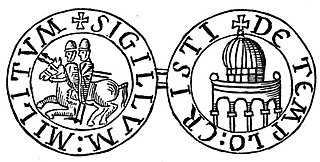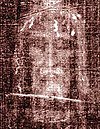Related Research Articles

The Poor Fellow-Soldiers of Christ and of the Temple of Solomon, mainly known as the Knights Templar, was a French military order of the Catholic faith, and one of the wealthiest and most popular military orders in Western Christianity. They were founded c. 1119 to defend pilgrims on their way to Jerusalem, with their headquarters located there on the Temple Mount, and existed for nearly two centuries during the Middle Ages.

Jacques de Molay, also spelled "Molai", was the 23rd and last grand master of the Knights Templar, leading the order sometime before 20 April 1292 until it was dissolved by order of Pope Clement V in 1312. Though little is known of his actual life and deeds except for his last years as Grand Master, he is one of the best known Templars.

Turin Cathedral is a Roman Catholic cathedral in Turin, northern Italy. Dedicated to Saint John the Baptist. It is the seat of the Archbishops of Turin.

The Chinon Parchment is a historical document discovered in September 2001 by Barbara Frale, an Italian paleographer at the Vatican Apostolic Archive. On the basis of this document she has claimed that, in 1308, Pope Clement V absolved the last Grand Master, Jacques de Molay, and the rest of the leadership of the Knights Templar from charges brought against them by the Medieval Inquisition.
The Poor Fellow-Soldiers of Christ and the Temple of Jerusalem, or Templars, was a military order founded in c. 1120.
Ludovico Geymonat was an Italian mathematician, philosopher and historian of science. As a philosopher, he mainly dealt with philosophy of science, epistemology and Marxist philosophy, in which he gave an original turn to dialectical materialism.

Remo Bodei was an Italian philosopher. He was a professor of the history of philosophy at the UCLA University, Los Angeles California, and also taught at the University of Pisa and Scuola Normale Superiore di Pisa. Bodei was born in Cagliari. His initial interests were in classical German philosophy, and the Weimar Classicism period (1770–1830). He subsequently penned over 200 papers on utopian thinkers of the eighteenth and nineteenth centuries, and contemporary political thought. He died in Pisa, aged 81.
Laurent Dailliez was a French history doctor who graduated from Ecole pratique des hautes études. He was a researcher in medieval studies at the CNRS, a historian of the Crusades, and a specialist of the Knights Templar. Among other books, he wrote "Les Templiers". Dailliez was also the author of the article on the Templars in the leading French language encyclopedia, Encyclopedia Universalis.

The Chapel of the Holy Shroud is a Baroque style Roman Catholic chapel in Turin in northern Italy, constructed to house the Shroud of Turin, a religious relic believed to be the burial shroud of Jesus of Nazareth. It is located adjacent the Turin Cathedral and connected to the Royal Palace of Turin. The chapel was designed by architect-priest and mathematician Guarino Guarini and built at the end of the 17th century (1668–1694), during the reign of Charles Emmanuel II, Duke of Savoy, and is considered one of the masterpieces of Baroque architecture. Heavily damaged in a fire in 1997, it underwent a complex 21 year restoration project, and reopened in 2018. The chapel has an intricate and self-supporting wooden and marble dome.

Renato Castellani was an Italian film director and screenwriter.

Arrigo Levi was an Italian journalist, essayist, and television anchorman.

In 1307, members of the Knights Templar in the Kingdom of France were suddenly charged with heresy and arrested after their leader, Master Jacques de Molay, had recently come to France for meetings with Pope Clement V. Many, including their leader, were burned at the stake while others were sentenced to perpetual imprisonment. The events in France led to a series of trials in other locations, not all of which had the same outcome.
Humbert de Pairaud was a dignitary of the Knights Templar in France and England from 1261 to 1275. He came from a noble family from Forez an old French province. He was installed as the commander of Ponthieu in 1257, master of the province of France, master of England and of Aquitaine between 1266 and 1271, and in the same period was the Visitor of France and England. Under his leadership, the following individuals were received into the Templars:

The History of the Shroud of Turin begins in the year 1390 AD, when Bishop Pierre d'Arcis wrote a memorandum where he charged that the Shroud was a forgery. Historical records seem to indicate that a shroud bearing an image of a crucified man existed in the possession of Geoffroy de Charny in the small town of Lirey, France around the years 1353 to 1357. The history from the 15th century to the present is well documented.
Attilio Celant, 2nd Class / Grand Officer of the Order of Merit of the Italian Republic, is an Italian economist, geographer and academic.
Laura Mancinelli was an Italian writer, Germanist, medievalist and university professor.

The Shroud of Turin is a length of linen cloth bearing the imprint of the image of a man, and is believed by some to be the burial shroud of Jesus. Despite conclusive scientific evidence from three radiocarbon dating tests performed in 1988 which resulted in the shroud being dated to 1260–1390 AD, some researchers have challenged the dating based on various theories, including the provenance of the samples used for testing, biological or chemical contamination, incorrect assessment of carbon dating data, as well as other theories. However, the alternative theories challenging the radiocarbon dating have been disproved by scientists using actual shroud material, and are thus considered to be fringe theories.
Elena Brambilla was an Italian historian.

Chiara Frugoni was an Italian historian and academic, specialising in the Middle Ages and church history. She was awarded the Viareggio Prize in 1994 for her essay, Francesco e l'invenzione delle stimmate.

The Templari Cattolici d'Italia (Catholic Templars of Italy) is the Knights Templar order reconstituted in Italy after the Templars were abolished on 22 March 1312 by the papal bull, Vox in excelso, issued by Pope Clement V. The Catholic Templars of Italy are a private association of Catholic faithfuls established according to canons 215/216 – Titulus I, de omnium christifidelium obligationibus et iuribus; can. from 321 to 326 – Titulus V, Caput III, de christifidelium consociationibus privatis of the Code of Canon Law.
References
- ↑ Frale, Barbara (2004), "The Chinon chart: Papal absolution to the last Templar, Master Jacques de Molay", Journal of Medieval History, 30 (2): 109–134, doi:10.1016/j.jmedhist.2004.03.004, S2CID 153985534
- ↑ University of Studies of Tuscia-Viterbo, matr. 985, Reg. 190/1/1
- ↑ "Index of /".
- ↑ http://www.ronchiato.it/sandona/comune/pavan.html%5B%5D
- ↑ University "Ca' Foscari" of Venice, Nr. 5/DR; Vatican School of Paleography, Diplomatics and Archival Science, Course of Paleography Diplomatics and Archival Science, Reg. N. 577; Course of Greek Paleography, Reg. N. 173; Deutsches Historische Institut im Rom, N. 2103-54/06 mc; Lʼattività della Santa Sede nel 2001, Libreria Editrice Vaticana, Città del Vaticano 2002, 1100–1106; Lʼattività della Santa Sede nel 2002, Città del Vaticano 2003, 1140–1142.
- ↑ The Chinon Parchment. Papal absolution to the last Templar Master Jacques de Molay, "The Journal of History", 30 (2004), 109–134; Du catharisme à la sorcellerie: les inquisiteurs du Midi dans le pròces des templiers, in Les ordres religieux militaires dans le Midi (XIIe-XIVe siècle), par A. Demurger, "Cahiers de Fanjeaux", 41 (2006), 169–186.
- ↑ Madras Editora Ldta, Santana 2005; Éditions Belin, 2008; Alianza Editorial, Madrid 2008; Świat Książki, Warszawa 2008, Arcade Publishing New York 2009; Argo, Praha 2009.
- ↑ U. Eco, Templari attendibili, La bustina di Minerva, "L'Espresso", 2 December 2004, p. 254
- ↑ Umberto Eco, Il Medioevo. Cattedrali, Cavalieri, Città , Encyclomedia Publishers, 2011. ISBN 978-88-209-8389-5
- ↑ M.C. Barber, The Trial of the Templars, Second Edition, "Cambridge University Press", Cambridge 2007, p. 306, 322, 333.
- ↑ A. Demurger, Chevaliers du Christ. Les ordres religieux-militaires au Moyen Âge, XIe-XVIe siècle, Éditions du Seuil, Paris 2002, p. 223
- ↑ http://www.comune.rieti.it/portalerieti/Evidenza/depliant%20santabarbara2010.pdf%5B%5D
- ↑ Broadcast in eurovision on RAI Vatican, live with Giuseppe De Carli and Orazio Coclite.
- 1 2 "Death certificate is imprinted on the Shroud of Turin, says Vatican scholar", Times of London, Richard Owen, 21 November 2009
- ↑ Daily Telegraph: "Jesus Christ's 'death certificate' found on Turin Shroud"
- ↑ The Jesus Inquest: The Case for and Against the Resurrection of the Christ by Charles Foster 2011 ISBN 0-8499-4811-8 Appendix 2: The Turin Shroud
- ↑ Vallerani, Massimo, "I templari e la Sindone: l'"ipotetica della falsità" e l'invenzione della storia", Historia Magistra, 2, 2009, abstract. Retrieved 24 October 2010
- ↑ "La Vecchia Lizza". www.lavecchializza.it. Archived from the original on 24 March 2012. Retrieved 6 June 2022.
